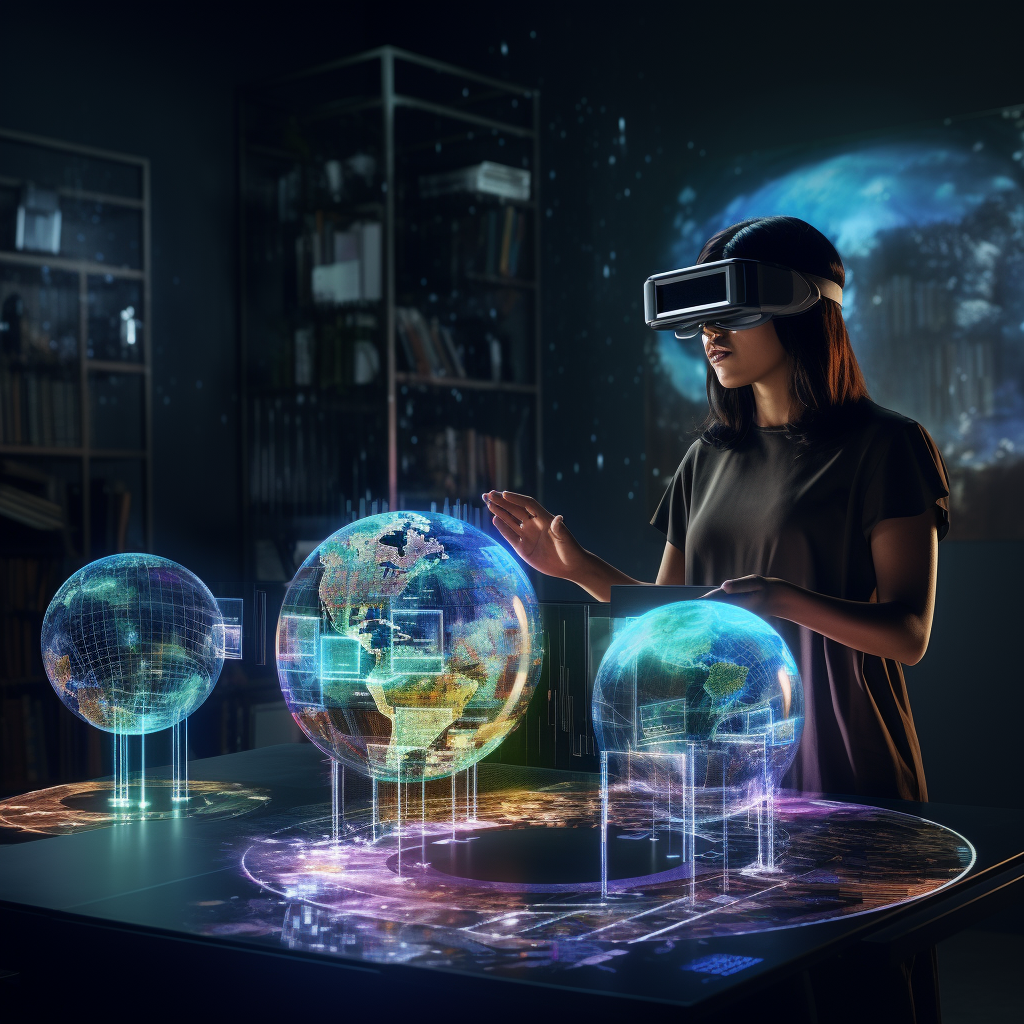
Categories

Building the Future: Creating Digital Twins in the Metaverse
The Metaverse has been gaining immense popularity over the past few years. The Metaverse has shown tremendous promise as an immersive digital world that provides an interactive experience for its users. Numerous applications, from entertainment to education and business, have become a part of the Metaverse spectrum.
Metaverse is made of various elements that constitute the virtual ecosystem. One such crucial element of the Metaverse is the concept of Digital Twins. Digital Twins are virtual prototypes or replicas of physical objects or systems which can be manipulated and controlled in a virtual environment. It is of utmost importance to understand Digital Twins in the Metaverse, the critical components required for creating a Digital Twin, the process of creating a Digital Twin, and various use cases of Digital Twins in the Metaverse. So, let’s dive in.
Key components needed to create a Digital Twin
Creating a Digital Twin in the Metaverse requires the following key components:
1. 3D Virtual environment: A virtual environment is the foundation of the entire Metaverse experience, which allows users to interact with and alter objects in the virtual space. The virtual environment can be created using various tools, such as Unreal Engine or Unity.
2. 3D modelling tools: Once the virtual environment is set up, 3D modelling tools are needed to create the digital twin. These tools allow designers to create a digital replica of the physical object or system they want to replicate. Popular tools include Blender, SketchUp, and Autodesk Maya.
3. Physics engine: A physics engine must ensure the digital twin behaves like its physical counterpart. It allows users to manipulate the digital twin in a similar fashion they would in the real world, including simulating realistic physics, such as gravity and collisions.
4. Interoperability standards: Interoperability standards are crucial to ensure the digital twin can interact with other digital twins and systems within the Metaverse. Standards such as the Open Metaverse Interoperability Group (OMG) and Virtual World Web (VWW) allow interoperability between different virtual environments.
Creating a Digital Twin
Creating a Digital Twin in the Metaverse involves the following steps:
Step 1: Define the digital twin’s characteristics and requirements
The first step in creating a digital twin is to define its characteristics and requirements. It includes determining the purpose of the digital twin, its functionality, and the level of detail required.
Step 2: Create the virtual environment
Once the characteristics and requirements of the digital twin have been defined, a virtual environment can be created. It involves selecting the appropriate 3D modelling tools and physics engine, as well as explaining the parameters of the virtual space, such as lighting and textures.
Step 3: Model the digital twin
With the virtual environment in place, the digital twin can be modelled using 3D modelling tools. The level of detail needed will depend on the purpose of the digital twin. For example, a digital twin of a building may require less detail than a machine’s digital twin.
Step 4: Integrate physics engine
Once the digital twin has been modelled, a physics engine can be integrated to ensure it behaves realistically. It involves defining the physics parameters, such as gravity and collisions, and testing the behaviour of the digital twin in the virtual environment.
Step 5: Ensure interoperability with other platforms
Finally, ensuring that the digital twin is interoperable with other platforms within the Metaverse is important. It involves adhering to interoperability standards and testing the digital twin’s compatibility with different virtual environments.
Use cases of Digital Twins in Metaverse
Digital Twins have numerous use cases in the Metaverse:
1. Smart cities and urban planning: Digital twins can be used to build virtual models of cities and urban areas, allowing planners to test and optimize infrastructure and resource management.
2. Industrial manufacturing: Industrial manufacturing and process control: Digital twins can be used to model manufacturing processes, optimize production, and train employees in safe and efficient procedures. In the manufacturing industry, digital twins can replicate physical machines, allowing engineers to test different scenarios and optimize the production process without shutting down the equipment. It can lead to considerable cost savings and increased efficiency. Additionally, digital twins can be deployed to train employees on how to operate machines and equipment safely, reducing the risk of accidents in the workplace.
3. Education and training: Digital twins can be used in educational settings to create interactive learning experiences. For example, a digital twin of a historical site could allow students to explore and learn about the site in a virtual environment. Similarly, a digital twin of a scientific experiment could enable students to manipulate variables and observe the results in a safe and controlled way.
4. Healthcare and medical training: Digital twins can simulate medical procedures and train healthcare professionals in a safe, controlled environment. Digital twins can replicate the human body and its organs, allowing medical professionals to practice. It can reduce the risk of errors during procedures and improve patient outcomes. Digital twins can also be used to train medical professionals in using equipment and devices, such as ventilators or ultrasound machines.
5. Entertainment and gaming: Digital twins can create immersive gaming experiences and interactive virtual events. Digital twins can create lifelike characters and environments in gaming, allowing for more realistic gameplay and immersive experiences. Digital twins can also be used for virtual events, such as conferences, concerts, and exhibitions, where many join people worldwide without having to travel physically. It can lead to increased accessibility and inclusivity.
Overall, digital twins in the Metaverse have the future to revolutionize various industries by improving efficiency, safety, and effectiveness in many areas. As the Metaverse evolves, the use cases for digital twins will expand, leading to more technological innovation and advancements.
Challenges and Opportunities for Digital Twins
While digital twins have numerous benefits, several challenges need to be addressed for their successful implementation in the Metaverse. Some of these challenges include:
Interoperability
One of the biggest challenges facing digital twins in the Metaverse is ensuring they are interoperable with other platforms and systems. With different virtual environments and technologies emerging, it is crucial that digital twins can interact with other platforms seamlessly. It requires the development of interoperability standards and protocols that can be adopted across different virtual environments.
Data privacy and security
Digital twins use sensitive data and information, which can be vulnerable to cyber threats and breaches. Proper security measures must be used to protect the data and ensure user privacy. It includes implementing secure data storage and encryption, as well as user authentication and access control.
Limited accessibility
Another challenge is the limited accessibility of digital twins to people who may not have the required technology or internet access. It can lead to unequal access to digital twin technologies, which can have broader implications for industries such as healthcare and education.
Despite these challenges, there are also numerous opportunities for digital twins in the Metaverse. Some of these include:
Increased efficiency and productivity
Digital twins can increase efficiency and productivity in various industries, including manufacturing, healthcare, and urban planning. By replicating physical objects and systems in a digital space, digital twins can allow testing and optimization without shutting down or disrupting real-world scenarios.
Improved safety and risk management
Digital twins can be used to simulate potentially dangerous scenarios and train employees in safe and efficient procedures. It can improve safety in industries such as manufacturing and healthcare, reducing the risk of accidents and improving outcomes for workers and patients.
Enhanced user experiences
Digital twins can create more immersive and interactive user experiences, particularly in the gaming and entertainment industries. It can increase user engagement and enjoyment and improve accessibility and inclusivity.
Conclusion
Digital twins have emerged as an elemental technology in the Metaverse, enabling the creation of realistic and interactive digital replicas of real-world objects and systems. By combining virtual environments, 3D modelling tools, physics engines, and interoperability standards, it is possible to create digital twins that behave like their physical counterparts and interact with other digital twins and systems within the Metaverse. As the Metaverse continues to grow, digital twins will likely play a significant role in shaping the virtual landscape and providing new opportunities for immersive experiences.
Despite some challenges, the opportunities presented by digital twins in the Metaverse are vast, and their potential to revolutionize various industries and transform the way we interact with digital environments cannot be understated. As the Metaverse continues to expand, it is clear that digital twins will be a key component in creating immersive and engaging virtual experiences for users.




Comments